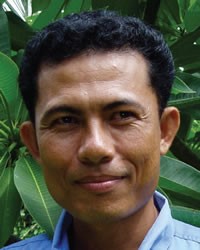Lao in Vietnam

Photo Source:
Cambodia Research Network
|
Send Joshua Project a map of this people group.
|
| People Name: | Lao |
| Country: | Vietnam |
| 10/40 Window: | Yes |
| Population: | 18,000 |
| World Population: | 4,114,000 |
| Primary Language: | Lao |
| Primary Religion: | Buddhism |
| Christian Adherents: | 3.40 % |
| Evangelicals: | 0.03 % |
| Scripture: | Complete Bible |
| Ministry Resources: | Yes |
| Jesus Film: | Yes |
| Audio Recordings: | Yes |
| People Cluster: | Lao |
| Affinity Bloc: | Southeast Asian Peoples |
| Progress Level: |
|
Introduction / History
Ancestors of the Lao once lived in China. Relentless pressure by the Chinese gradually forced them southward, and many settled along the Mekong River in the eighth or ninth century. The Lao language is among the Tai linguistic group, which moved southward with them from China and morphed into the language it is today. Variations of this language are spoken by the peoples we now call Lao. Laos is surrounded by much more powerful neighbors including Vietnam.
There has been mixing of ethnic groups in Southeast Asia ever since French colonial days. France controlled what is now Vietnam, Cambodia and Laos. Lao people were sometimes moved to Vietnam to work in mines or on farms. Others went to Hanoi to study at the university level. Laotian government workers were sometimes trained in Vietnam. Generations later a small number of their descendants still live in Vietnam.
What Are Their Lives Like?
Most of the Lao are wet rice farmers. They also raise cotton, mulberry bushes (for silkworms), coco palms and various fruits. Cultivation is done with wooden equipment drawn by buffalo. Some of the farmers are also blacksmiths, carpenters or miners. Iron and tin are exploited, as well as some gold. Certain villages specialize in crafts such as pottery, or in the production of goods such as tobacco or charcoal. A number of the Lao are also fishermen.
The Lao live in villages alongside rivers or near roads that give them access to Chinese merchants. Their villages range in size from ten to several hundred families. Lao houses are typically made of wood or bamboo and are built high on stilts. Family livestock, which includes poultry, pigs and goats, is allowed to run freely underneath the houses. Nearly every family raises cattle and buffaloes, to trade the leather and hides.
Lao social structure is based on family units, with no widespread lineages or clans. Sexual promiscuity before marriage is relatively common.
The Lao have a variety of folk arts, which include weaving, basket making, wood and ivory carving, and working with silver and gold. They have a variety of musical instruments, of which a bamboo wind instrument called the khene is the most widely known. Lam is a musical form common to the Lao. It combines music with poetry and storytelling. Their traditional literature has been influenced by both Hinduism and Buddhism. The Lao enjoy soccer, boat racing, Ka-taw or kick-volleyball and martial arts.
What Are Their Beliefs?
Kunfal are strongly Ethiopian Orthodox Christians and very resistant to any form of Protestant Christianity. The Awi people accepted Orthodox Christianity hundreds of years ago and have integrated it into their culture.
What Are Their Needs?
Kunfal churches need a fresh work of the Holy Spirit. As it stands, many have allowed traditions to become more important than a relationship with Jesus Christ.
Prayer Points
Pray for a movement to call Lao people to Jesus Christ.
Pray for power encounters that will clearly show to the Lao people that Christ has far more power than the spirit world.
Ask the Lord to thrust out loving workers to the Buddhist Lao people in Vietnam.
Pray for effective strategies to reach them along with essential prayer efforts.
Ask God to use Lao believers to share the love of Jesus with their own people in Vietnam.